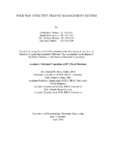| dc.contributor.advisor | Rahim, Abu Hamed M. Abdur | |
| dc.contributor.advisor | Sabuj, Saifur Rahman | |
| dc.contributor.author | Mehraj, Fahad Sharif | |
| dc.contributor.author | Humayun, Samin Bin | |
| dc.contributor.author | Hossain, Md. Shafayet | |
| dc.contributor.author | Addree, Asfi Adrin | |
| dc.date.accessioned | 2023-09-20T06:15:29Z | |
| dc.date.available | 2023-09-20T06:15:29Z | |
| dc.date.copyright | 2023 | |
| dc.date.issued | 2023-04 | |
| dc.identifier.other | ID 19121115 | |
| dc.identifier.other | ID 19121143 | |
| dc.identifier.other | ID 19121129 | |
| dc.identifier.other | ID 19121100 | |
| dc.identifier.uri | http://hdl.handle.net/10361/21064 | |
| dc.description | This thesis is submitted in partial fulfillment of the requirements for the degree of Bachelor of Science in Electrical and Electronic Engineering, 2023. | en_US |
| dc.description | Cataloged from PDF version of thesis. | |
| dc.description | Includes bibliographical references (pages 58-59). | |
| dc.description.abstract | This study presents a comprehensive approach to developing an effective traffic management
system for a four-way intersection. To optimize traffic flow and alleviate congestion, the
system incorporates fuzzy logic, image processing, and proximity sensors. The study
compares the performance of each technology and concludes that proximity sensors are the
best option due to their high accuracy, low cost, and ease of deployment.
The suggested system detects the presence of vehicles and adjusts traffic lights in real time
using proximity sensors. The duration of the green light is controlled by fuzzy logic based on
the number of vehicles in each lane, while image processing is employed to detect and
respond to emergency vehicles.
The system is tested using simulations and demonstrates considerable improvements in traffic
flow and waiting times, particularly during high traffic hours. The study emphasizes
proximity sensors' potential as a cost-effective and dependable solution for traffic control
systems, particularly in developing nations. The findings of this research can help
transportation planners and policymakers design successful traffic control systems in their
cities. | en_US |
| dc.description.statementofresponsibility | Fahad Sharif Mehraj | |
| dc.description.statementofresponsibility | Samin Bin Humayun | |
| dc.description.statementofresponsibility | Md. Shafayet Hossain | |
| dc.description.statementofresponsibility | Asfi Adrin Addree | |
| dc.format.extent | 70 pages | |
| dc.language.iso | en | en_US |
| dc.publisher | Brac University | en_US |
| dc.rights | Brac University theses are protected by copyright. They may be viewed from this source for any purpose, but reproduction or distribution in any format is prohibited without written permission. | |
| dc.subject | Traffic management system | en_US |
| dc.subject | Four-way intersection | en_US |
| dc.subject | Fuzzy logic | en_US |
| dc.subject | Image processing | en_US |
| dc.subject | Proximity sensors | en_US |
| dc.subject | Traffic flow | en_US |
| dc.subject | Congestion | en_US |
| dc.subject | Real-time | en_US |
| dc.subject | Green light | en_US |
| dc.subject | Vehicle detection | en_US |
| dc.subject | Emergency vehicles | en_US |
| dc.subject | Simulations | en_US |
| dc.subject | Peak traffic hours | en_US |
| dc.subject | Developing countries | en_US |
| dc.subject | Transportation planning | en_US |
| dc.subject.lcsh | Image processing--Digital techniques. | |
| dc.subject.lcsh | Proximity detectors | |
| dc.subject.lcsh | Computer engineering | |
| dc.title | Four way effective traffic management system | en_US |
| dc.type | Thesis | en_US |
| dc.contributor.department | Department of Electrical and Electronic Engineering, Brac University | |
| dc.description.degree | B. Electrical and Electronic Engineering | |

